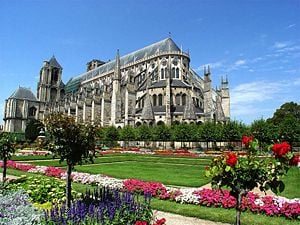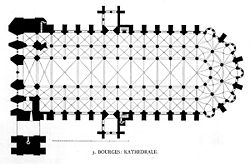Difference between revisions of "Bourges Cathedral" - New World Encyclopedia
David Doose (talk | contribs) m (→External links) |
David Doose (talk | contribs) m (→Paintings) |
||
| Line 51: | Line 51: | ||
The discovery of emblematic murals (in the sacristy of the Chapter House decorated by Jacques Coeur in honor of Charles VII around 1450) was followed by another more enigmatic one: the [[frescoe]]s of the [[Crucifixion]] on a seascape background and of the resurrection of Christ in the Chapel of Du Breuil which date from about 1475. | The discovery of emblematic murals (in the sacristy of the Chapter House decorated by Jacques Coeur in honor of Charles VII around 1450) was followed by another more enigmatic one: the [[frescoe]]s of the [[Crucifixion]] on a seascape background and of the resurrection of Christ in the Chapel of Du Breuil which date from about 1475. | ||
| − | The astronomical clock and clockface representing the signs of the [[Zodiac]], painted by [[Jean d'Orleans]], have been restored. The original mechanism, which is the work of Canon Fusoris (1424) is well-preserved.<ref>[http://www.ville-bourges.fr/english/heritage/cathedral.php Bourges cathedral] ''Ville-bourges.fr.'' Retrieved April 15, 2009.</ref> | + | The astronomical clock and clockface representing the signs of the [[Zodiac]], painted by [[Jean d'Orleans]], have been restored. The original mechanism, which is the work of [[Canon Fusoris]] (1424), is well-preserved.<ref>[http://www.ville-bourges.fr/english/heritage/cathedral.php Bourges cathedral] ''Ville-bourges.fr.'' Retrieved April 15, 2009.</ref> |
==Notes== | ==Notes== | ||
Revision as of 23:22, 15 April 2009
| Bourges Cathedral* | |
|---|---|
| UNESCO World Heritage Site | |

| |
| State Party | |
| Type | Cultural |
| Criteria | i, iv |
| Reference | 635 |
| Region** | Europe and North America |
| Inscription history | |
| Inscription | 1992 (16th Session) |
| * Name as inscribed on World Heritage List. ** Region as classified by UNESCO. | |
Bourges Cathedral (Cathédrale Saint-Étienne de Bourges) is a cathedral, dedicated to Saint Stephen, located in Bourges, France. It is the seat of the Archbishop of Bourges.
It is based on the Notre-Dame in Paris but with significant differences in design. For its unique feats of architecture, impressive sculptures and 13th-century stained glass windows, Bourges Cathedral has been designated a World Heritage Site by UNESCO.
History
The cathedral has been a site of Christian worship since the 3rd century, when the Roman city of Avaricum sheltered the first Christian community in Gaul. Successive monumental crypts were built here in the 3rd, 4th and 9th centuries.
The first Cathedral of Bourges was a Romanesque edifice, built in the 11th century by Archbishop Gozlin, the brother of Robert II of France. A century later, this was determined to be too small; rebuilding in the brand-new Gothic style began in 1195. Funding was provided in large part by a donation from Henri de Sully, Bishop of Bourges (and brother of the Bishop of Paris).
Construction began in 1195, the same time as Chartres Cathedral. The lower church was built about 1200, followed by the choir above it in 1214. Glazing of the windows in the ambulatory was underway between about 1215 and 1225. The nave was finished by about 1230, then work slowed down considerably. The architect was Paul-Louis Boeswillwald and the master builder was Philip Berruyer.
The west facade was constructed throughout the latter half of the 13th century. In 1313, great cracks began to appear in the southern tower, which had to be supported by extensive buttressing. Structural problems made it impossible to mount bells so it came to be called a "deaf tower."
The new Cathedral of Bourges was finally dedicated on May 13, 1324, but the north tower was still incomplete. This was finished by the end of the 15th century, but then came crashing down in 1505. The north tower was rebuilt in 1542 in a Gothic style harmonious with the much older facade, although some Renaissance elements crept in. It is known as the Tour de Beurre (Butter Tower), since it was funded by offering donors an exemption from fasting during Lent.[1]
The cathedral is the burial place of William of Donjeon (c. 1155 - January 10, 1209), who was Archbishop of Bourges from 1200 until 1209.
The cathedral was added to the list of the World Heritage Sites by UNESCO in 1992.
Dimensions and structure
The cathedral's nave is 15m wide by 37m high; its arcade is 20m high; the inner aisle is 21.3m and the outer aisle is 9.3m high. The use of flying buttresses was employed to help the structure of the building. However, since this was a fairly new technique, one can easily see the walls were still made quite thick to take the force. Sexpartite vaults are used to span the nave.
Notable features
Bourges Cathedral has a highly unique floor plan. It has no transepts, which form the cross-shape of most churches. This lends the cathedral a unique appearance inside and out. On the exterior, thick walls and a myriad of flying buttresses support the unbroken weight of the long nave (122m/400 ft).[1]
Bourges is also notable for the unity of its design, seen in no other cathedral of the High Gothic era. It features two distinct horseshoe aisles that wrap around a central nave and choir). The inner aisle has a higher vault than the outer aisle.[2] Each ambulatory/aisle has its own portal at the west end. The five portal entrance necessitated more careful design to create a more coherent façade. This also eliminated the usual cross-shaped transept design.[3] The gallery is absent; instead the inner aisle has been raised. This gives the cathedral a pyramidal shape under the buttresses. The flying buttresses are very structurally efficient (particularly compared to those at Chartres, which is a contemporary structure) as the steep angle channels the thrust from the nave vaults and from wind loading more directly to the outer buttress piers.
The Great Tower is a copy of one found at the Louvre and symbolizes royal power. The statues on the façade smile at the tympanum of the Last Judgment, welcoming the Judgment of Christ. The Romanesque carved portals from about 1160-70, probably intended for the facade of the earlier cathedral, have been reused on the south and north doors. The profuse ornamentation is reminiscent of Burgundian work.
Stained glass
Bourges Cathedral retains almost all its original ambulatory glass (apart from the axial chapel), dating from about 1215. The iconography used in many of these windows uses typology (such as Old Testament episodes prefiguring events in the life of Christ) and symbolism (such as the pelican who pecks her breast to feed her young on her own blood and the lioness who licks the malformed cub into shape) to communicate theological messages. Other windows show the parables of the Good Samaritan and the Prodigal Son, the story of Dives and Lazarus, and the Apocalypse.
Of the original 25 windows, 22 survive. The three windows in the central east chapel were lost. The large windows in the main wall of the ambulatory are entirely original. Unfortunately the narrower windows in the chapels have lost their original lower registers, due to Baroque altar installation in the 17th century. These panels were replaced in the 19th century with medieval-style stained glass of high quality, but without reference to the lost originals.[1]
Paintings
The discovery of emblematic murals (in the sacristy of the Chapter House decorated by Jacques Coeur in honor of Charles VII around 1450) was followed by another more enigmatic one: the frescoes of the Crucifixion on a seascape background and of the resurrection of Christ in the Chapel of Du Breuil which date from about 1475.
The astronomical clock and clockface representing the signs of the Zodiac, painted by Jean d'Orleans, have been restored. The original mechanism, which is the work of Canon Fusoris (1424), is well-preserved.[4]
Notes
- ↑ 1.0 1.1 1.2 Bourges Cathedral Sacred-destinations.com. Retrieved April 15, 2009.
- ↑ Bony, Jean (1985). French Gothic Architecture of the Twelfth and Thirteenth Centuries, p. 212. University of California Press. ISBN 0520055861.
- ↑ Marshall, Herbert Menzies, and Marshall, Hester (1907). Cathedral Cities of France, p. 160. London: William Heinemann.
- ↑ Bourges cathedral Ville-bourges.fr. Retrieved April 15, 2009.
ReferencesISBN links support NWE through referral fees
- Bayard, Tania. 1976. Bourges Cathedral: The West Portals. Outstanding dissertations in the fine arts. New York: Garland. ISBN 0824019776
- Branner, Robert, and Shirley Prager Branner. 1989. The Cathedral of Bourges and its place in Gothic Architecture. Architectural History Foundation books. New York, N.Y.: Architectural History Foundation. ISBN 0262022761
- Pryce, Will. 2008. World Architecture: The Masterworks. (London): Thames & Hudson. ISBN 9780500342480
External links
All links retrieved April 15, 2009.
- Sacred Destinations: Bourges Cathedral Sacred-destinations.com
- History of Gothic Architecture: Bourges Kyoto-inet.or.jp.
- Bourges Cathedral at UNESCO World Heritage Whc.unesco.org.
- City of Bourges: Saint-Etienne cathedral Ville-bourges.fr.
- Bourges Cathedral - Medieval Stained Glass Medievalart.org.
Coordinates:
Credits
New World Encyclopedia writers and editors rewrote and completed the Wikipedia article in accordance with New World Encyclopedia standards. This article abides by terms of the Creative Commons CC-by-sa 3.0 License (CC-by-sa), which may be used and disseminated with proper attribution. Credit is due under the terms of this license that can reference both the New World Encyclopedia contributors and the selfless volunteer contributors of the Wikimedia Foundation. To cite this article click here for a list of acceptable citing formats.The history of earlier contributions by wikipedians is accessible to researchers here:
The history of this article since it was imported to New World Encyclopedia:
Note: Some restrictions may apply to use of individual images which are separately licensed.

